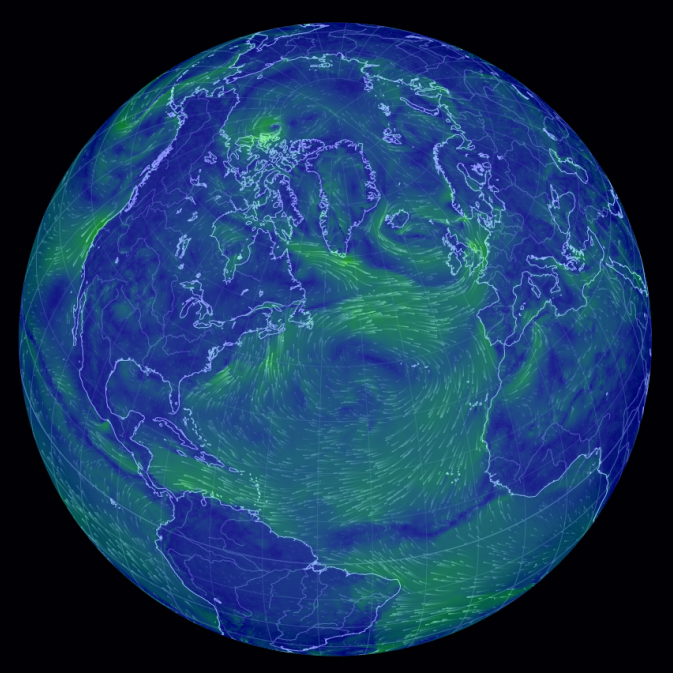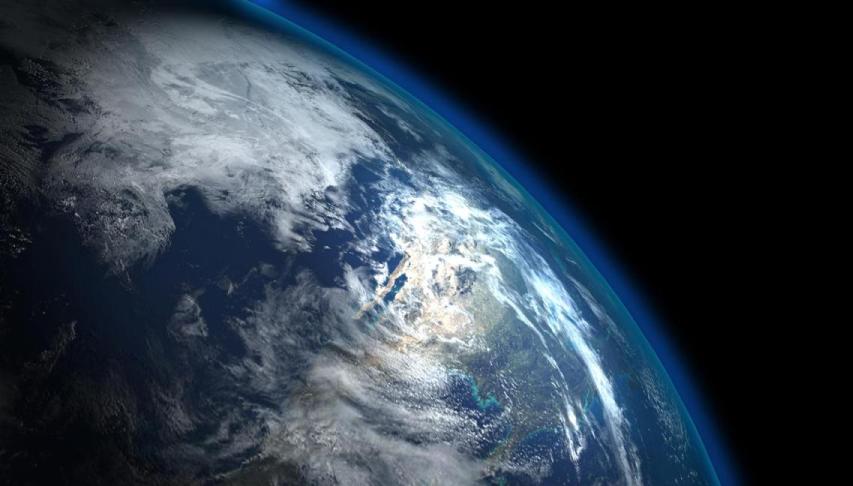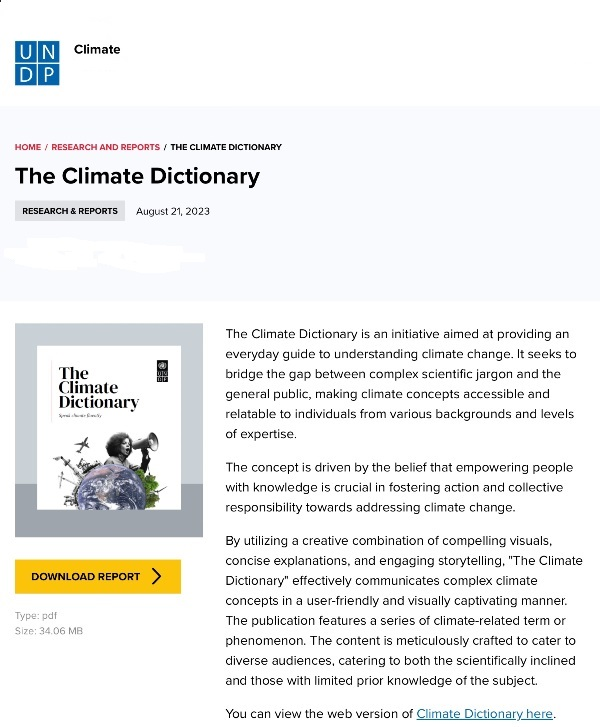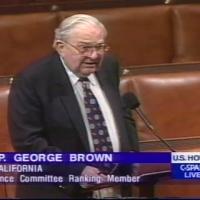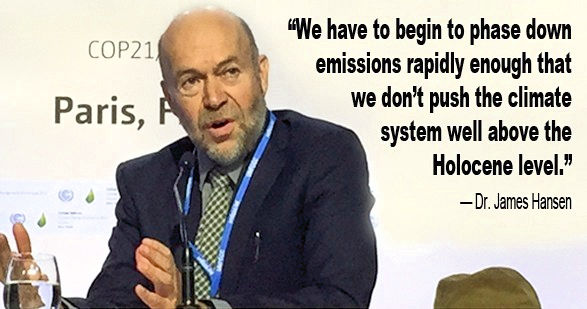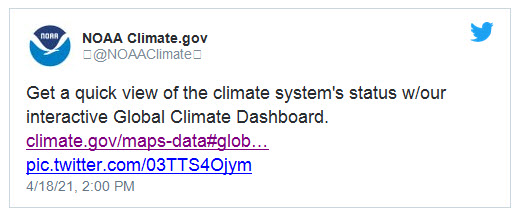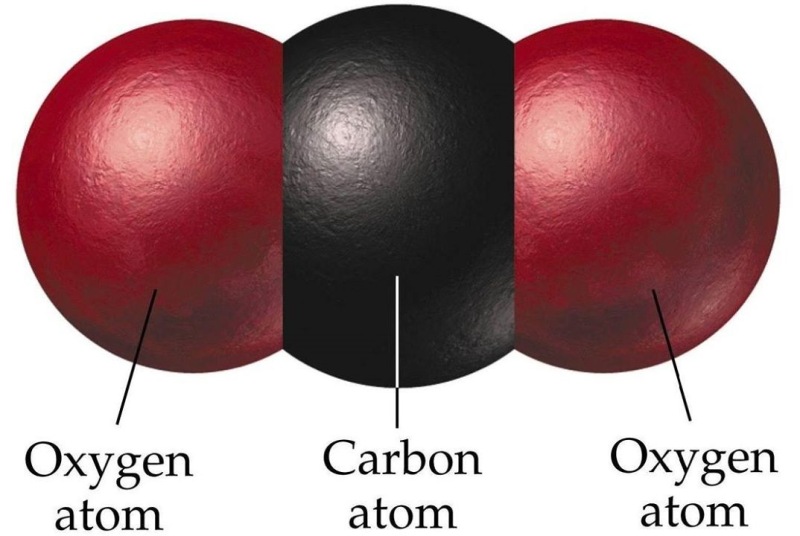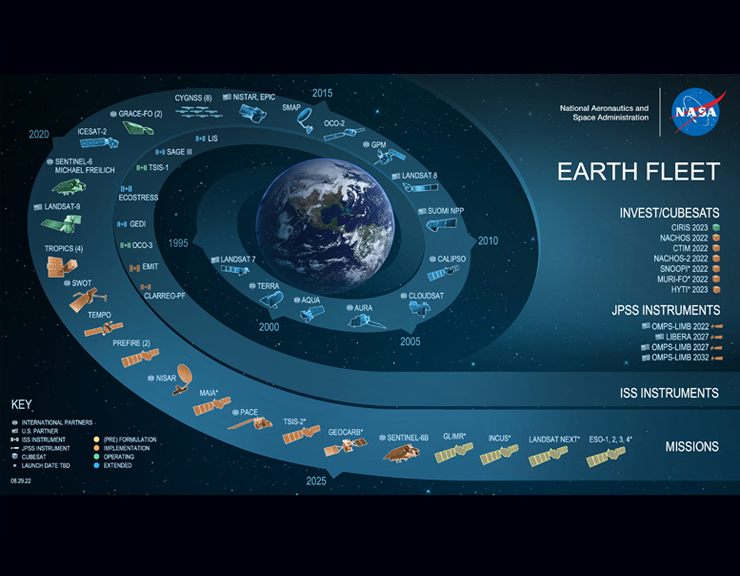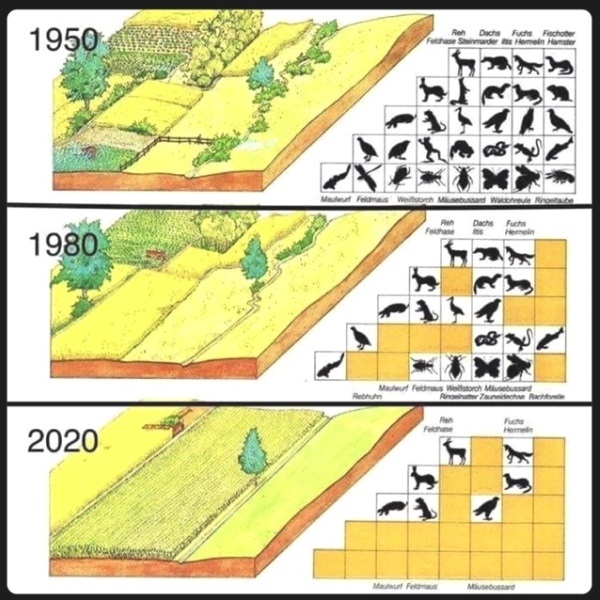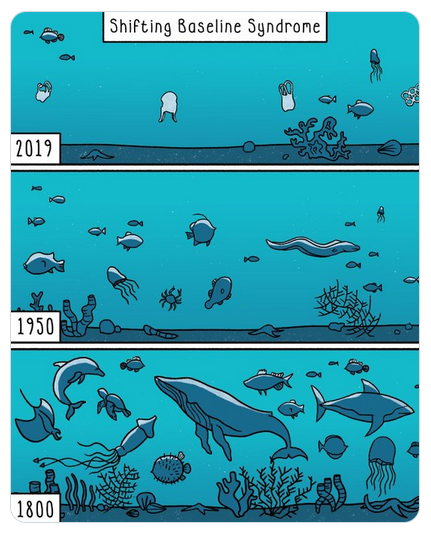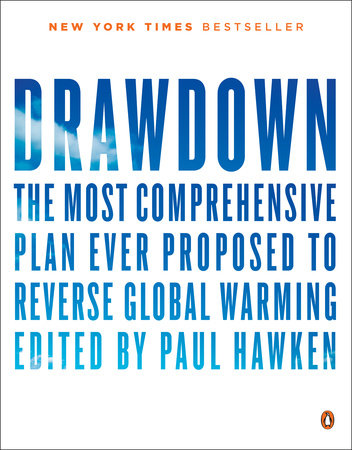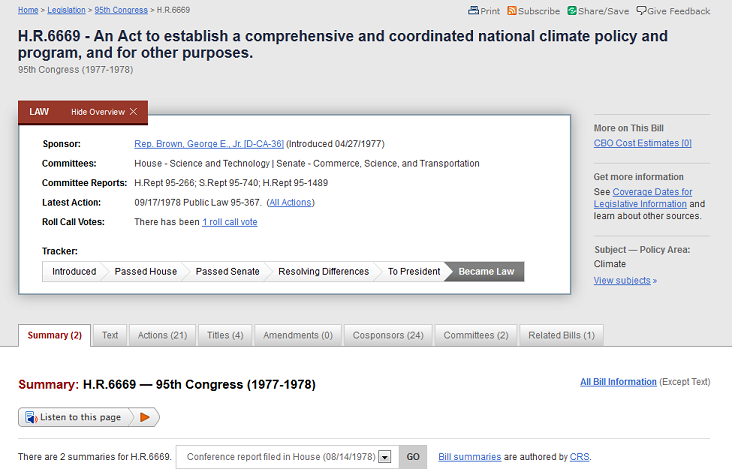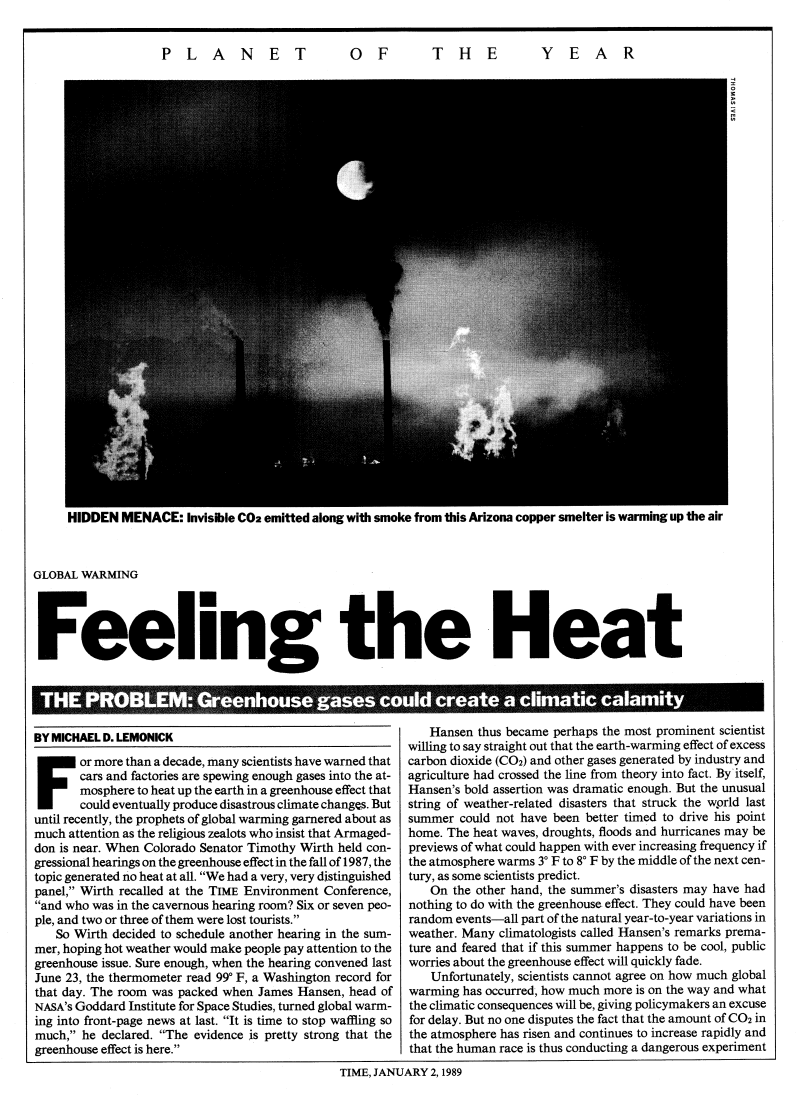Climate Change - Global Warming Keyword-Terms: Difference between revisions
Siterunner (talk | contribs) No edit summary |
Siterunner (talk | contribs) No edit summary |
||
| (128 intermediate revisions by the same user not shown) | |||
| Line 1: | Line 1: | ||
[[File:Earth conditions dynamic map.png]] | :[[File:Earth conditions dynamic map.png]] | ||
:* https://earth.nullschool.net/#current/wind/surface/level/orthographic | |||
:<big>'''Begin with Where You Are on Planet Earth...'''</big> | |||
:[https://earth.nullschool.net/#current/wind/surface/level/orthographic/ '''Tap 'n see your location's and global current conditions'''] | |||
'''Eco-tags / Eco-news''' | | ||
GreenPolicy360: '''Knowledge of climate change and the language of climate science continues to change and evolve.''' | |||
From a 1977 [https://www.greenpolicy360.net/mw/images/Energy_and_Climate_Report%2C_1977%2C_National_Academy_of_Sciences.pdf '''Energy and Climate Report of the U.S. National Academy of Sciences'''], then 1978 first-ever [https://www.greenpolicy360.net/w/File:US_Public_Law_95-367.png '''National Climate Act/Program'''] drafted and passed by the U.S. Congress in 1978, that was followed in 1979 by a [https://www.nap.edu/read/12181/chapter/1 '''National Academy Climate Science report'''] (that was [https://phys.org/news/2019-07-charney-years-scientists-accurately-climate.html '''presciently accurate'''] in its predictions) and through decades of research, science and climate activism up until today, the [https://greenpolicy360.net/w/File:You_can_manage_only_what_you_can_measure_Dr_David_Crisp,_OCO-2,_June_2014_m.jpg ''''measuring and monitoring''''] of climate facts and data have increased in volume and accuracy -- as climate change has sparked debate around the world. | |||
<big>'Earth is in our hands', 'Earth is in your hands'</big> | |||
'''[[Planet Citizens, Planet Scientists]]'''... We can see looking back, from the 1970s on, the challenge has been to develop Atmospheric and Earth Science to track and act on climate change, climate impacts and related threats and disruptions as the extent of the developing climate crisis comes into view. | |||
Now, together, the next steps are ours... | |||
[[File:Earth in Our Hands.png]] | |||
| |||
'''[[Thin Blue Layer]]''' | |||
* https://greenpolicy360.net/w/Thin_Blue_Layer | |||
* https://www.greenpolicy360.net/w/Look_at_how_thin_our_atmosphere_is | |||
[[File:'Thin Blue Layer' of Earth's Atmosphere l.jpg]] | |||
"Thin Blue" | |||
| |||
<big><big><big>'''[[National Climate Plans]]'''</big></big></big> | |||
The fact is -- In the modern era human activities are pumping vast quantities of emissions ([https://greenpolicy360.net/w/Environmental_full-cost_accounting '''"externalities"''']) into the "Thin Blue" layer of Earth's atmosphere | |||
The question is -- What are we, all of us, as communities, regions, nations of the world going to do about the reality we are creating that is threatening life on Earth? | |||
GreenPolicy360 journeys across 50+ years of the modern environmental movement. | |||
GreenPolicy360 believes '''[[Green Education]]''' is our responsibility to take up together. | |||
* https://greenpolicy360.net/w/Category:Education | |||
* https://www.greenpolicy360.net/w/Green_Education | |||
* https://greenpolicy360.net/w/Category:Ecology_Studies | |||
| |||
<big><big><big>'''[[Planet Citizen Action]]'''</big></big></big> | |||
: <big><big><big>'''[[Generation Green]]'''</big></big></big> | |||
Picture New Visions of Security, Local/National/Global | |||
Change is All Around, Now is the Time to Act to Make a Positive Difference | |||
* https://www.greenpolicy360.net/w/Category:Strategic_Demands | |||
* https://www.greenpolicy360.net/w/New_Definitions_of_National_Security | |||
* https://www.greenpolicy360.net/w/Look_at_how_thin_our_atmosphere_is | |||
* https://www.greenpolicy360.net/w/Earth_and_Space,_Politics | |||
* https://www.greenpolicy360.net/w/Planet_API | |||
[[File:Change.jpg]] | |||
[[File:The Climate Dictionary - as of 2023.png]] | |||
| |||
<big><big>'''The Climate Dictionary'''</big></big> | |||
: You can view the web version of Climate Dictionary [https://climatepromise.undp.org/research-and-reports/climate-dictionary '''here'''] | |||
:* https://climatepromise.undp.org/research-and-reports/climate-dictionary | |||
UNDP: The Climate Dictionary is an initiative aimed at providing an everyday guide to understanding climate change. It seeks to bridge the gap between complex scientific jargon and the general public, making climate concepts accessible and relatable to individuals from various backgrounds and levels of expertise. | |||
🌎 | |||
<big>'''"Climate Change" or "Climate Crisis"?</big> | |||
In 2019 The Guardian updated its Style Guide for reporters, writers, and editors. We can see this as a reflection of how keywords and terms within climate science are becoming more precise ... review the article that is titled: | |||
"It's a crisis, not a change": six Guardian language changes on climate matters... | |||
* https://www.theguardian.com/environment/2019/oct/16/guardian-language-changes-climate-environment | |||
🌎 | |||
<big><big>''' "Climate Change" or "Global Warming"?'''</big></big> | |||
'''Explore the evolution of the terms 'climate change' and 'global warming'.''' | |||
'''Look back to the 1975 scientific paper by Wally Broecker that is often credited with introducing warnings of "Global Warming".''' | |||
Dr. Wallace Broecker became known over subsequent years for having 'popularized' the term 'global warming' (although he said he didn't want the credit 'on his tombstone'.) | |||
* https://weather.com/news/news/2019-02-18-wally-broecker-dies-global-warming | |||
* https://www.npr.org/2019/02/18/695797869/grandfather-of-climate-science-wallace-broecker-dies-at-87 | |||
* https://www.nytimes.com/2019/02/19/obituaries/wallace-broecker-dead.html | |||
* https://eapsweb.mit.edu/news/2019/remembering-wallace-broecker | |||
<font color=green>○ ○ ○ ○ ○ ○ ○ ○ ○ ○ ○</font> | |||
'''GreenPolicy360 Siterunner:''' The beginnings of modern environmental and climate science can be traced to the 1960s and 1970s. The U.S. National Academy of Sciences played a key role in laying a foundation of scientific reports and data and, in 1977-78, I watched and participated in the discussion, debate and drafting of climate legislation, '''the first National Climate Act'''. The principal author of the legislation was my good friend, [https://www.greenpolicy360.net/w/George_E._Brown_Jr Representative George E. Brown] from my home town, Monterey Park in East Los Angeles. | |||
[[File:George Brown, Sci Com't.jpg]] | |||
Congressman Brown was attempting to define and set out a course of action that the National Academy of Sciences had began to describe in 1977/1979 as a gathering global threat. The terms used to described the threat were both "global warming" and "climate change". | |||
Representative Brown became known, in his three decades of leadership in the U.S. Congress as the 'Big Science' mover and shaker. Often behind the scenes, George Brown, as a friend, mentor, and then colleague of GreenPolicy360's founder-siterunner, led in the oversight committee that envisioned, set in motion missions and programs, and managed policies and politics of Earth Science and Atmospheric Science, planet imaging/observations (e.g. Landsat in its foundational digital measuring/monitoring of Earth's changing systems), technology, environmental legislation (including the establishment of the EPA), and on and on... The first national (and as it was passed in the 1970s) international climate act was a program that came from George Brown's hands... | |||
<big><big>'''National Climate Program Act (1978)'''</big></big> | |||
'''An Act to establish a comprehensive and coordinated national climate policy and program, and for other purposes''' | |||
'''95th Congress (1977-1978)''' | |||
:'''Authored by Rep. George E. Brown''' | |||
:: [http://www.greenpolicy360.net/mw/images/National_Climate_Program_Act_Public_Law_95-367_Sept_1978.pdf ''National Climate Program Act - 1978''] | |||
A decade after the 1978 National Climate Act, a prominent scientist, Jim Hansen became a national news story. In testimony before the U.S. Senate, [https://www.greenpolicy360.net/w/File:Hansen_testimony_WaPo_front_page.jpg Jim Hansen used the term 'global warming'] in his extensively reported 'dire warning' that the world faced a crisis as, due to greenhouse gas emissions from the burning of fossil fuels, the world was entering a new era of environmental disruption. Scientists pointed at the consequences of CO2 emissions, global warming producing, in turn, atmospheric systems disruption, drought, severe weather events, air pollution, biodiversity loss, extensive human costs. Political reactions varied from efforts to protect and secure a safe environment to political forces fighting against the new environmental agenda and attempting to maintain the vast power and reach of the fossil fuel industry. | |||
Those of us who were activists faced daunting odds in making change even as news headlines began to be featured by some newspaper and media reports. | |||
'''[[About Us]]''' | |||
* https://www.greenpolicy360.net/w/About_Us | |||
* https://www.greenpolicy360.net/w/Green_Policy:About | |||
The science of climate and global warming, the big picture, begins to reach the mainstream media (MSM) with the widely reported coverage of Dr. Hansen's 1988 warnings of global warming. Public awareness of climate change moves forward and citizen activism becomes a call to action... | |||
[[File:Hansen-testimony-1988.jpg]] | |||
[https://www.greenpolicy360.net/w/PlanetCitizen <big><big>'''Planet citizens step up'''</big></big>] | |||
<big>'''[[Going Green]]'''</big> | |||
* https://www.greenpolicy360.net/w/Going_Green | #GoingGreen | |||
* https://www.greenpolicy360.net/w/Green_Quotes | Green Quotes | |||
'''Green 'Vita Activa' ''' | |||
* https://www.greenpolicy360.net/w/Planet_Citizen_Action | Planet Citizen Action | |||
:* https://www.greenpolicy360.net/w/Climate_Problems,_Climate_Solutions | Climate Problems, Climate Solutions | |||
'''New Visions of Security ''' | |||
* http://www.greenpolicy360.net/w/New_Definitions_of_National_Security | New Definitions of National Security | |||
* http://www.greenpolicy360.net/w/Category:Environmental_Security | Environmental Security | |||
* http://www.greenpolicy360.net/w/Category:Environmental_Security,_National_Security | Environmental Security - National Security | |||
* https://www.greenpolicy360.net/w/Surviving_Victory:_Security_Priorities | "Surviving Victory" | |||
<font color=green>○ ○ ○ ○ ○ ○ ○ ○ ○ ○ ○ ○ ○ ○ ○ ○ ○ ○ ○ ○ ○ ○ ○ ○</font> | |||
<big>'''Climate Change & Global Warming -- Definitions, a History:'''</big> | |||
'''"Inadvertent climate modification"''' | |||
* https://www.nasa.gov/topics/earth/features/climate_by_any_other_name.html | |||
'''Beyond "Inadvertent climate modification" -- Wally's Global Warming Warning''' | |||
* https://gpm.nasa.gov/education/articles/whats-name-global-warming-vs-climate-change | |||
* https://climate.nasa.gov/resources/global-warming-vs-climate-change/ | |||
* https://www.energyandcapital.com/articles/the-name-game-from-global-warming-to-climate-change-/97908 | |||
* https://skepticalscience.com/climate-change-global-warming.htm | |||
* https://www.history.com/topics/natural-disasters-and-environment/history-of-climate-change | |||
* https://www.123helpme.com/essay/When-Did-Global-Warming-Become-Climate-Change-180237 | |||
* https://www.cnn.com/2019/03/02/world/global-warming-climate-change-language-scn/index.html | |||
* https://weather.com/news/climate/news/2018-01-29-climate-change-global-warming-trump-piers-morgan | |||
* https://www.climaterealityproject.org/blog/difference-between-global-warming-and-climate-change | |||
<big>'''Corporate Public Relations for Oil/Gas Reframes Global Warming Facts and Science'''</big> | |||
* https://www.cell.com/one-earth/fulltext/S2590-3322(21)00233-5 | |||
The first deep analysis of MobilExxon communications policy/communications about climate change/global warming. | |||
(excerpt from the study) | |||
After the 1999 Mobil and Exxon merger... >Mobil advertorials disproportionately contested climate science head-on, discussing emission(s) of CO2/carbon dioxide and the global warming effect (terms exhibiting statistically significant divergence are underlined throughout). Mobil advertorials also notably engaged in climate policy debates concerning the role of the US (and Senate) compared with other nations as part of the Kyoto treaty plan. By contrast, ExxonMobil Corp advertorials no longer referred to “global warming”: the term became taboo (FS = 0.10). Relative usage of “climate change” versus “global warming” went from 3-to-1 pre-merger to 34-to-1 post merger. Indeed, ExxonMobil Corp mostly sidestepped detailed discussions about climate science, acknowledging only the long-term risks of climate change before reframing it as a challenge to meet the public's energy demand and needs. ExxonMobil Corp advertorials emphasized the need for more climate and energy technologies research, such as the company's sponsorship of the GCEP (Global Climate and Energy Project) at Stanford University. Current solar and wind technologies were presented as inadequate. | |||
Advertorials versus internal documents | |||
Comparing divergent terms in all advertorials against those in internal documents, a combination of the above advertorial themes emerges (Tables 2 and 4). Numerous Mobil and ExxonMobil Corp advertorials promoted explicit doubt about whether AGW is real and human caused. They emphasized debate and focused on what scientists “do and don't know” [Climate science uncertainty] (topic labels from Table 4 are indicated in bracketed italics throughout). This eventually gave way to rhetoric about potential long-term risks of AGW (after several years of overlap in ∼2000–2005 and 2007)... | |||
<font color=green>○ ○ ○ ○ ○ ○ ○ ○ ○ ○ ○ ○ ○ ○ ○ ○ ○ ○ ○ ○ ○ ○ ○ ○ ○ ○ ○ ○ ○ ○ ○ ○ ○ ○ ○ ○</font> | |||
[https://19january2017snapshot.epa.gov/climatechange/glossary-climate-change-terms_.html <big>'''Glossary of Climate Change Terms (as of 2019) - US Environmental Protection Agency'''</big>] | |||
* https://earthobservatory.nasa.gov/glossary | |||
'''Climate Change - Global Warming - Science Glossary & Terms''' | |||
* https://www.climaterealityproject.org/blog/key-terms-you-need-understand-climate-change | |||
* https://climatechange.ucdavis.edu/science/climate-change-definitions/ | |||
* https://skepticalscience.com/glossary.php | |||
[[File:James-hansen.jpg]] | |||
<big><big>'''Eco-tags / Eco-news'''</big></big> | |||
:https://www.greenpolicy360.net/w/GTN_GreenLinks_Trending_News | :https://www.greenpolicy360.net/w/GTN_GreenLinks_Trending_News | ||
'''Global weirding''': ''Slang term for climate change, coined by Hunter Lovins, co-founder of the Rocky Mountain Institute, a US-based energy think-tank. The term has been catching on in cyberspace, as it aptly sums up the crazy impact of global warming — more intense heat and cold spells in some places, shorter winters and longer droughts in others, excessive flooding in more places, more frequent and bigger cyclones, and so on.'' | |||
'''Energy-exia''': ''A combination of energy and anorexia. Refers to people who follow an extremely strict carbon-footprint regimen. The New York Times, the daily newspaper, coined the term in an article in October 2008 about "energy anorexics" – people who grow their own produce, air-dry their clothes, and let their children share beds to pool body heat.'' | |||
'''Eco-hacking''' or '''Geo-engineering''': ''The use of science in large-scale projects to change the environment or stop global warming, for example, by putting reflectors on ocean surfaces to reflect sunlight back into the atmosphere, as suggested by US president Lyndon Johnson's advisors when scientists warned of the impact of carbon dioxide on the climate in the 1960s. Kind of B-grade sci-fi as the Guardian newspaper in the UK put it.'' | |||
'''Ecoflation''': Inflation caused by ecological problems in the future, such as water scarcity, which would push the price of production up. The term was used in a report, 'Rattling Supply Chains', co-authored by the World Resources Institute, the US-based environmental think-tank, which looked into the cost of production in the future expected to rise when the implementation of climate change policy would result in a price for greenhouse gas emissions, water scarcity; and deforestation policies. | |||
'''Green audit''': ''An assessment to determine the environmental impact of an activity, product, or production process by examining, for example, the use of energy, the type of raw materials, and disposal of any waste materials.'' | |||
'''Greenwashing''': ''Refers to repositioning a product to stress its eco-friendly attributes; it can even apply to politicians, according to scientist Jim Hansen.'' | |||
'''Locavore''': ''Someone who tries to eat food grown within a certain radius of their home; the food not only tastes better because it is fresher, but less energy is wasted in transporting it. The term was coined by US chef Jessica Prentice.'' | |||
''' | '''Precycle''': ''The practice of reducing waste by making a conscious effort, for instance, buying consumables in bulk to reduce packaging, or choosing products in recyclable packaging instead of those in non-recyclable materials, and using electronic media for reading material rather than throwaway items like magazines or newspapers.'' | ||
······································ | |||
'''Climate | <big><big>'''EcoInternet Search'''</big></big> | ||
* https://search.ecointernet.org/ | |||
<big><big>'''Eco-Search Engine'''</big></big> | |||
* https://www.ecosia.org | |||
······································ | |||
<big><big>'''Evolving list of scientific & popular terms'''</big></big> | |||
A - | |||
<big>[[Anthropocene]]</big> | |||
* http://www.greenpolicy360.net/w/Anthropocene | |||
<big>[[Anthropogenic climate disruption (ACD)]]</big> | |||
* https://www.greenpolicy360.net/w/Anthropogenic_climate_disruption_(ACD) | |||
'''AGW''' - Anthropogenic Global Warming | |||
* http://climate.nasa.gov/scientific-consensus/- http://climate.nasa.gov/climate_resources/139/ | |||
'''Antarctic Melt''' | |||
* https://www.greenpolicy360.net/w/Category:Antarctica | |||
* http://www.npr.org/2015/03/26/395379216/big-shelves-of-antarctic-ice-melting-faster-than-scientists-thought | |||
'''Arctic Sea Ice Melt''' | |||
* https://www.greenpolicy360.net/w/Category:Arctic | |||
* http://www.huffingtonpost.com/news/arctic-ice-melt/ | |||
'''Atmosphere / Atmospheric Science''' | |||
* http://www.greenpolicy360.net/w/Category:Atmospheric_Science - http://www.thinbluelayer.com | |||
B - | |||
'''Biofuels''' | |||
Gas or liquid fuel made from plant material. Includes wood, wood waste, wood liquors, peat, railroad ties, wood sludge, spent sulfite liquors, agricultural waste, straw, tires, fish oils, tall oil, sludge waste, waste alcohol, municipal solid waste, landfill gases, other waste, and ethanol blended into motor gasoline. | |||
'''Biomass''' | |||
Materials that are biological in origin, including organic material (both living and dead) from above and below ground, for example, trees, crops, grasses, tree litter, roots, and animals and animal waste. | |||
'''Biosphere''' | |||
The part of the Earth system comprising all ecosystems and living organisms, in the atmosphere, on land (terrestrial biosphere) or in the oceans (marine biosphere), including derived dead organic matter, such as litter, soil organic matter and oceanic detritus. | |||
C - | |||
'''Climate Action Plan (CAP)''' | |||
* https://www.c2es.org/document/climate-action-plans/ - http://www.ca-ilg.org/climate-action-plans | |||
'''Climate Change''' | |||
* http://www.greenpolicy360.net/w/Category:Climate_Change | |||
'''Climate Migration''' - '''Environmental Migrants''' | |||
* https://en.wikipedia.org/wiki/Environmental_migrant | |||
* http://climatemigration.org.uk/about-us/ | |||
: '''Mass Migration''' - as result of war/environmental disruption | |||
* https://en.wikipedia.org/wiki/File:Map_of_the_European_Migrant_Crisis_2015.png | |||
* http://www.bbc.com/news/world-36573082 | |||
'''CH4 - Methane''' | |||
* https://en.wikipedia.org/wiki/Methane | |||
'''CO2 - Carbon Dioxide''' - https://www3.epa.gov/climatechange/ghgemissions/gases/co2.html | '''CO2 - Carbon Dioxide''' - https://www3.epa.gov/climatechange/ghgemissions/gases/co2.html | ||
[[File:Global climate dashboard-NOAA climate.gov.jpg]] | |||
[[File:CH4 graph - 1980-2020.JPG]] | |||
| |||
[[File:CO2 photo.JPG]] | |||
| |||
D - | |||
'''Data''' | |||
A collection of facts, concepts or instructions in a formalized manner suitable for communication or processing by human beings or by computer. | |||
'''Data set''' | |||
A logically meaningful grouping or collection of similar or related data. Data having mostly similar characteristics (source or class of source, processing level and algorithms, etc.) | |||
[[File:You can manage only what you can measure Dr David Crisp, OCO-2, June 2014 m.jpg]] | |||
E - | |||
'''Earth Observing System''' - NASA | |||
[[File:Earth Observing System - fleet of satellites.png]] | |||
''' | ''' 'Ecocide’ ''' | ||
* https://en.wikipedia.org/wiki/Ecocide / ec·o·cide /ˈēkōˌsīd,ˈekōˌsīd/ | |||
(Oxford Dictionary) - Destruction of the natural environment, especially when willfully done. "Their crime is nothing less than attempted ecocide." | |||
'' | ''"The rainforests of the Amazonia, sub-Sahraran Africa, and Borneo/Indonesia are indispensable ecological resources of the planet whose managerial control should not be left entirely to national discretion as exercised by governments, often on the basis of economistic and short-term policy goals, which is currently almost invariably the case. This statist sovereignty approach not only puts at risk the planet’s largest carbon sink and most valued source of biodiversity, as well as disrupting and imperiling the lives of 20 million or more people, mostly indigenous communities, living in Amazonia. Forest experts warn that once a rainforest is degraded beyond a certain point, a tipping point is reached, and the degrading will continue of its own accord until what was once a flourishing rainforest becomes a huge area savannah grasslands. Even before tipping points are reached it takes decades to restore forest ecosystems, including precious biodiversity resources."'' -- Richard Falk (2019) | ||
:Type in "Eco-nomics" | |||
'''Extinction''' | |||
* https://www.greenpolicy360.net/w/Extinction | |||
············ | |||
<big><big><big>'''[[Eco-nomics]]'''</big></big></big> | |||
* https://www.greenpolicy360.net/w/Eco-nomics | |||
: '''@ Google Scholar''' -- Go online to https://scholar.google.com/ ... | |||
Type in "Eco-nomics" ... compare content from scholarly journals cited by Google and GreenPolicy360's -- https://www.greenpolicy360.net/w/Category:Eco-nomics | |||
············ | |||
<big><big><big>'''[[Environmental full-cost accounting]]''' '''</big></big></big> | |||
* https://www.greenpolicy360.net/w/Environmental_full-cost_accounting | |||
'''Environmental Security (Global Security, National Security Strategy)''' | '''Environmental Security (Global Security, National Security Strategy)''' | ||
* http://www.greenpolicy360.net/w/New_Definitions_of_National_Security | |||
* http://www.greenpolicy360.net/w/Category:Environmental_Security | |||
:http://strategicdemands.com/new-definitions-of-security/ | |||
* http://strategicdemands.com/environmental-security/ | |||
* https://www.greenpolicy360.net/w/Category:Global_Security | |||
* http://strategicdemands.com/new-definitions-of-security/ | |||
<big><big><big>'''[https://www.greenpolicy360.net/w/Category:Externalities Externalities]''' '''</big></big></big> | |||
''' | : '''Harmful Externalities''' (External Costs) - http://enduse.lbl.gov/Info/Externalities.pdf | ||
''' | '''Extreme Weather''' | ||
* https://en.wikipedia.org/wiki/Extreme_weather | |||
F - | |||
''' | '''Feedback mechanisms''' | ||
Factors which increase or amplify (positive feedback) or decrease (negative feedback) the rate of a process. An example of positive climatic feedback is the ice-albedo feedback. | |||
''' | '''Fluorocarbons''' | ||
Carbon-fluorine compounds that often contain other elements such as hydrogen, chlorine, or bromine. Common fluorocarbons include chlorofluorocarbons and related compounds (also know as ozone depleting substances). | |||
G - | |||
'''LANCE''' (Land, Atmosphere Near-real-time Capability for EOS) | '''Global Commons''' | ||
* https://en.wikipedia.org/wiki/Global_commons - http://www.planetcitizen.org | |||
'''Global Warming''' | |||
* https://en.wikipedia.org/wiki/Global_warming | |||
'''GHG - Greenhouse Gas''' | |||
* https://en.wikipedia.org/wiki/Greenhouse_gas | |||
'''GISS / Goddard Institute for Space Studies''' | |||
* http://www.giss.nasa.gov/ | |||
'''Gravity Waves (atmospheric)''' | |||
* https://en.wikipedia.org/wiki/Gravity_wave | |||
* https://en.wikipedia.org/wiki/Atmospheric_wave | |||
'''Greenland (Ice Sheet Melt)''' | |||
* https://en.wikipedia.org/wiki/Greenland_ice_sheet | |||
H - | |||
'''Holocene''' | |||
* https://en.wikipedia.org/wiki/Holocene | |||
'''Hydroflourocarbon''' \ | |||
* https://en.wikipedia.org/wiki/Hydrofluorocarbon | |||
I - | |||
'''IceBridge / Operation IceBridge''' | |||
* https://www.nasa.gov/mission_pages/icebridge/index.html | |||
* https://en.wikipedia.org/wiki/Operation_IceBridge | |||
'''ICLEI – Local Governments for Sustainability''' | |||
* https://en.wikipedia.org/wiki/ICLEI | |||
J - | |||
'''Jet Stream - Hemispherical Jet Streams''' - [https://youtu.be/_nzwJg4Ebzo "Understanding the Jet Stream" - Video] | |||
* https://robertscribbler.com/2016/06/28/gigantic-gravity-waves-to-mix-winter-with-summer-wrecked-jet-stream-now-runs-from-pole-to-pole/ | |||
K - | |||
'''Keeling Curve''' | |||
* https://en.wikipedia.org/wiki/Keeling_Curve | |||
'''Oh NOAA, Oh Mauna Loa, Oh Keeling''' | |||
* https://gml.noaa.gov/ccgg/trends/graph.html | |||
https://gml.noaa.gov/webdata/ccgg/trends/co2_data_mlo.png | |||
L - | |||
'''La Nina''' | |||
* https://en.wikipedia.org/wiki/La_Ni%C3%B1a | |||
'''LANCE''' (Land, Atmosphere Near-real-time Capability for EOS) | |||
* https://earthdata.nasa.gov/earth-observation-data/near-real-time | |||
M - | |||
'''Megadrought''' - https://en.wikipedia.org/wiki/Megadrought | '''Megadrought''' - https://en.wikipedia.org/wiki/Megadrought | ||
'''Methane''' - https://en.wikipedia.org/wiki/Methane | '''Methane''' - https://en.wikipedia.org/wiki/Methane | ||
: -- Bill McKibben: (at the 2016 Democratic Party platform meeting) People used to routinely refer to natural gas as a bridge fuel that would help us overcome our climate woes. As with many things, this turned out to be much too good to be true. The problem is that if it escapes unburned into the atmosphere, each molecule of methane, CH4, depending on the timeframe you measure it on, about 86 times more powerful greenhouse gas molecule for molecule than CO2. | : -- Bill McKibben: (at the 2016 Democratic Party platform meeting) People used to routinely refer to natural gas as a bridge fuel that would help us overcome our climate woes. As with many things, this turned out to be much too good to be true. The problem is that if it escapes unburned into the atmosphere, each molecule of methane, CH4, depending on the timeframe you measure it on, about 86 times more powerful greenhouse gas molecule for molecule than CO2. | ||
* https://upload.wikimedia.org/wikipedia/commons/thumb/9/9b/Methane-2D-dimensions.svg/170px-Methane-2D-dimensions.svg.png | |||
'''Montreal Protocol''' - https://en.wikipedia.org/wiki/Montreal_Protocol - Due to its widespread adoption and implementation it has been hailed as an example of exceptional international co-operation, with Kofi Annan quoted as saying that "perhaps the single most successful international agreement to date has been the Montreal Protocol" ... When comparing this very success story with attempts to establish an international policy on the Earth's climate or atomic energy, the entire process from a problem formulation to a global acceptance supported by a legal framework took less than a quarter of a single human generation live span. | |||
[[Montreal Protocol]] '''"Ozone Hole" and International CFC Mitigation Accord''' | |||
Among the treaty's accomplishments | Among the treaty's accomplishments: The Montreal Protocol was the first international treaty to address a global environmental regulatory challenge; the first to embrace the "precautionary principle" in its design for science-based policymaking; the first treaty where independent experts on atmospheric science, environmental impacts, chemical technology, and economics, reported directly to Parties, without edit or censorship, functioning under norms of professionalism, peer review, and respect; the first to provide for national differences in responsibility and financial capacity to respond by establishing a multilateral fund for technology transfer; the first MEA with stringent reporting, trade, and binding chemical phase-out obligations for both developed and developing countries; and, the first treaty with a financial mechanism managed democratically by an Executive Board with equal representation by developed and developing countries. | ||
"Amazing Recovery" - and Model for Potential of International Cooperation on Climate Issues - http://www.csmonitor.com/Science/2016/0630/Gaping-hole-in-ozone-layer-shows-amazing-recovery-say-scientists | "Amazing Recovery" - and Model for Potential of International Cooperation on Climate Issues - http://www.csmonitor.com/Science/2016/0630/Gaping-hole-in-ozone-layer-shows-amazing-recovery-say-scientists | ||
N - | |||
'''NASA''' | '''NASA''' | ||
:http://www.greenpolicy360.net/w/ | * https://en.wikipedia.org/wiki/NASA | ||
* http://www.greenpolicy360.net/w/Earth_Science_Vital_Signs | |||
* http://www.greenpolicy360.net/w/Earth_Right_Now | |||
* http://www.greenpolicy360.net/w/Earth_Science_Research_from_Space | |||
* http://www.greenpolicy360.net/w/OCO-2 | |||
* http://www.greenpolicy360.net/w/New_Definitions_of_National_Security | |||
* http://www.greenpolicy360.net/w/Category:Environmental_Security | |||
: http://www.greenpolicy360.net/w/Climate_Resilience_Toolkit-USA.GOV-NOAA-NASA | |||
: http://www.greenpolicy360.net/w/NASA_EarthSciences,_Challenges_Public_to_Join_In | |||
'''OCO-2''' - Orbiting Carbon Observatory | '''NCAR''' | ||
* https://ncar.ucar.edu/ | |||
'''NOAA''' | |||
* https://en.wikipedia.org/wiki/National_Oceanic_and_Atmospheric_Administration | |||
O - | |||
'''OCO-2''' - Orbiting Carbon Observatory | |||
* http://www.greenpolicy360.net/w/OCO-2 | |||
| Line 120: | Line 653: | ||
P - | |||
''' | '''Paris Climate Summit''' | ||
* http://www.greenpolicy360.net/w/Climate_Change_Summit_Paris | |||
* http://www.greenpolicy360.net/w/Intended_Nationally_Determined_Contributions | |||
* http://www.greenpolicy360.net/w/IPCC_Report_Nov_2014 | |||
'''Particulate Pollution''' (atmospheric) | |||
* https://en.wikipedia.org/wiki/Particulates | |||
* http://www.greenpolicy360.net/w/Category:Air_Pollution | |||
* http://www.greenpolicy360.net/w/Category:Air_Quality | |||
* http://www.greenpolicy360.net/w/Category:Atmospheric_Science | |||
Q - | |||
'''QBO''' | |||
* https://en.wikipedia.org/wiki/Quasi-biennial_oscillation | |||
R - | |||
<big>'''''Representative Concentration Pathway'''''</big> | <big>'''''Representative Concentration Pathway'''''</big> | ||
| Line 136: | Line 688: | ||
'''"Rossby Whistle"''' - "a deep whistling sound offshore in the Caribbean - an A flat - some call it 'a Rossby'", an oscillating of the earth's gravity field and it's changing its tone... the Rossby can be heard as far away as from space | '''"Rossby Whistle"''' - "a deep whistling sound offshore in the Caribbean - an A flat - some call it 'a Rossby'", an oscillating of the earth's gravity field and it's changing its tone... the Rossby can be heard as far away as from space | ||
* https://youtu.be/kSlVKTbdGUU | |||
* http://thescienceexplorer.com/nature/caribbean-sea-whistles-so-loud-it-can-be-heard-space | |||
'''Runaway Climate Change''' / Runaway Greenhouse Effect / "Human-Induced Hothouse" | |||
* https://en.wikipedia.org/wiki/Climate_state#Hothouse | |||
S - | |||
'''Seasonality''' | |||
* https://en.wikipedia.org/wiki/Seasonality | |||
'''Scanning radiometer''' | |||
An imaging system consisting of lenses, moving mirrors, and solid-state image sensors used to obtain observations of the Earth and its atmosphere. Scanning radiometers, which are the sole imaging systems on all current operational weather satellites, have far better long-term performance than the vidicon TV camera tubes used with earlier spacecraft. See Sensor. | |||
'''Sea level''' | |||
The datum against which land elevation and sea depth are measured. Mean sea level is the average of high and low tides. | |||
sea surface temperature (SST) | |||
The temperature of the layer of seawater (approximately 0.5 m deep) nearest the atmosphere. | |||
'''Sea-level rise''' | |||
* https://www.greenpolicy360.net/w/Sea-Level_Rise | |||
'''Sensor (remote sensing / satellite earth science - atmospheric science)''' | |||
Device that produces an output (usually electrical) in response to stimulus such as incident radiation. Sensors aboard satellites obtain information about features and objects on Earth by detecting radiation reflected or emitted in different bands of the electromagnetic spectrum. Analyzing the transmitted data provides valuable scientific information about Earth. | |||
Weather satellites commonly carry radiometers, which measure radiation from snow, ice, clouds, and bodies of water. Spaceborne radars are used for Earth observations, bouncing radar waves off land and ocean surfaces to study sea-surface conditions, ice thickness, and land surface features. A wind scatterometer is a special type of radar designed to measure ocean surface winds indirectly by bouncing signals off the water and measuring them from various angles. Infrared (IR) detectors measure heat generated by Earth features in the IR band of the spectrum. | |||
Photographic reconnaissance sensors in their simplest form are large telescope-camera systems used to view objects on Earth's surface. The bigger the lens, the smaller the object that can be detected. Camera-telescope systems now incorporate all sorts of sophisticated electronics to produce better images, but even these systems need cloudless skies, excellent lighting, and good color contrast between objects and their surroundings to detect objects the size of a basketball. Some of the satellites produce film images that must be returned to Earth, but a more convenient method is to record the image as a series of digital code numbers, then reconstruct the image from the electronic code using a computer at a ground station. See Spectrophotometer | |||
'''Shifting Baselines''' | |||
* https://en.wikipedia.org/wiki/Shifting_baseline | |||
* https://www.greenpolicy360.net/w/File:Shifting_Baseline_Syndrome_-_threats_to_ecosystems_biodiversity.png | |||
[[File:Shifting Baselines 2.jpg]] | |||
:::[[File:Shifting Baseline Syndrome - threats to ecosystems biodiversity.png]] | |||
''' | '''Spectrophotometer''' | ||
A device for measuring the relative amounts of radiant energy or radiant flux as a function of wavelength. | |||
:'''Eyes on the Earth''' | |||
[[File:Multispectral Scanning Systen - MSS.jpg]] | |||
Multispectral', Digital and Dynamic -- https://landsat.gsfc.nasa.gov/ | |||
* https://www.greenpolicy360.net/w/Landsat_data_users_handbook | |||
'''Surface air temperature''' | |||
The temperature of the air near the surface of the Earth, usually determined by a thermometer in an instrument shelter about 2 m above the ground. The true daily mean, obtained from a thermograph, is approximated by the mean of 24 hourly readings and may differ by 1.0 degrees C from the average based on minimum and maximum readings. The global average surface air temperature is 15 degrees C. | |||
'''Sustainable Development''' | |||
* https://en.wikipedia.org/wiki/Sustainable_development | |||
* https://www.un.org/sustainabledevelopment/ | |||
T - | |||
'''"Thin Blue"''' | |||
* http://www.thinbluelayer.com | |||
'''"Tiny Blue-Green"''' | |||
* http://www.tinybluegreen.com | |||
U - | |||
'''Ultraviolet radiation''' | |||
The energy range just beyond the violet end of the visible spectrum. Although ultraviolet radiation constitutes only about 5 percent of the total energy emitted from the sun, it is the major energy source for the stratosphere and mesosphere, playing a dominant role in both energy balance and chemical composition. | |||
Most ultraviolet radiation is blocked by Earth's atmosphere, but some solar ultraviolet penetrates and aids in plant photosynthesis and helps produce vitamin D in humans. Too much ultraviolet radiation can burn the skin, cause skin cancer and cataracts, and damage vegetation. | |||
'''United States Geological Survey (USGS)''' | |||
A bureau of the Department of the Interior. USGS was established in 1879 following several Federally sponsored independent natural resource surveys of the West and Midwest. The Department of the Interior has responsibility for most of our nationally owned public lands and natural resources. The USGS monitors resources such as energy, minerals, water, land, agriculture, and irrigation. The resulting scientific information contributes to environmental-policy decision making and public safety. For example, USGS identifies flood- and landslide-prone areas and maintains maps of the United States. | |||
V - | |||
'''Vegetation Canopy Lidar (VCL)''' | |||
The first satellite mission of NASA's Earth System Science Pathfinder project that will create the first maps of the three-dimensional structure of vegetation in the world's forests. The VCL lidar holds five lasers that each send 242 pulses per second at the Earth's surface. Each beam covers an area 75 feet across. By spacing the five beams a little over a mile apart, each VCL orbit will sample an area 5 miles across. | |||
W - X / Y / Z | |||
'''Water cycle''' | |||
The process by which water is transpired and evaporated from the land and water, condensed in the clouds, and precipitated out onto the earth once again to replenish the water in the bodies of water on the earth | |||
'''Zonal Wind Patterns''' | |||
* https://en.wikipedia.org/wiki/Extratropical_cyclone | |||
| Line 159: | Line 828: | ||
https://www.greenpolicy360.net/w/ProjectDrawdownCO2 | * https://www.greenpolicy360.net/w/ProjectDrawdownCO2 | ||
* http://www.drawdown.org/solutions | |||
http://www.drawdown.org/solutions | * http://www.drawdown.org/solutions-summary-by-rank | ||
| Line 170: | Line 840: | ||
<big>'''Read more about the early days of #ClimateAction'''</big> | <big>'''Read more about the early days of #ClimateAction'''</big> | ||
<big><big>'''[[Our Biggest Experiment]]'''</big></big> | |||
| Line 175: | Line 848: | ||
https://www.greenpolicy360.net/w/George_E._Brown_Jr | * https://www.greenpolicy360.net/w/George_E._Brown_Jr | ||
<big>'''Congressman Brown / Science Committee in Front of Climate Action'''</big> | <big>'''Congressman Brown / Science Committee in Front of Climate Action'''</big> | ||
http://www.greenpolicy360.net/w/File:Congressman_george.e.brown.gif | * http://www.greenpolicy360.net/w/File:Congressman_george.e.brown.gif | ||
[http://www.greenpolicy360.net/mw/images/National_Climate_Program_Act_Public_Law_95-367_Sept_1978.pdf '''National Climate Program Act, 1978 / PDF'''] | [http://www.greenpolicy360.net/mw/images/National_Climate_Program_Act_Public_Law_95-367_Sept_1978.pdf '''National Climate Program Act, 1978 / PDF'''] | ||
| Line 198: | Line 871: | ||
https://www.greenpolicy360.net/w/File:Hansen-testimony-1988.jpg | * https://www.greenpolicy360.net/w/File:Hansen-testimony-1988.jpg | ||
https://www.greenpolicy360.net/w/File:Hansen_testimony_WaPo_front_page.jpg | * https://www.greenpolicy360.net/w/File:Hansen_testimony_WaPo_front_page.jpg | ||
| Line 208: | Line 881: | ||
https://www.greenpolicy360.net/w/File:Gavin_Schmidt_TW-Dec8,2016.png | * https://www.greenpolicy360.net/w/File:Gavin_Schmidt_TW-Dec8,2016.png | ||
| Line 218: | Line 891: | ||
'''CLIMATE-CHANGE | ACRONYMS''' | |||
:AEA: Atomic Energy Act | |||
:AIA: American Institute of Architects | |||
:BAT: best available technology | |||
:BLM: Bureau of Land Management | |||
:BOEM: Bureau of Energy Management | |||
:CAA: Clean Air Act | |||
:CCS: carbon capture and sequestration | |||
:CEQ: Council on Environmental Quality | |||
:CES: clean energy standard | |||
:CFC: chlorofluorocarbon | |||
:CO2: carbon dioxide | |||
:CO2eq: carbon dioxide equivalent | |||
:CRP: Conservation Reserve Program | |||
:CSP: Conservation Stewardship Program | |||
:DAC: direct air capture | |||
:DDPP: Deep Decarbonization Pathways Project | |||
:DG: distributed generation | |||
:DOE: U.S. Department of Energy | |||
:DPF: diesel particulate filter | |||
:EERS: energy-efficiency resource standard | |||
:EIS: environmental impact statement | |||
:EISA: Energy Independence and Security Act | |||
:EPA: U.S. Environmental Protection Agency | |||
:EPAct 2005: Energy Policy Act of 2005 | |||
:EPCA: Energy Policy and Conservation Act | |||
:EQIP: Environmental Quality Incentives Program | |||
:EOS Earth Observing System | |||
:ESA: Endangered Species Act | |||
:ETS: emissions trading scheme | |||
:EU: European Union | |||
:EVs: electric vehicles | |||
:FAA: Federal Aviation Administration | |||
:FAST: Fixing America’s Surface Transportation Act | |||
:FCIC: Federal Crop Insurance Corporation | |||
:FERC: Federal Energy Regulatory Commission | |||
:FHA: Federal Housing Administration | |||
:FITs: feed-in tariffs | |||
:FONSI: finding of no significant impact | |||
:FPA: Federal Power Act | |||
:FSA: Farm Service Agency | |||
:FWS: U.S. Fish and Wildlife Service | |||
:GHG: greenhouse gas | |||
:Gt: gigaton | |||
:GST global stocktake | |||
:GWP: global warming potential | |||
:HCFC: hydrochlorofluorocarbon | |||
:HDVs: heavy-duty vehicles | |||
:HFC: hydrofluorocarbon | |||
:HFCV: hydrogen fuel cell vehicle | |||
:ICAO: International Civil Aviation Organization | |||
:IMO: International Maritime Organization | |||
:IPCC: Intergovernmental Panel on Climate Change | |||
:ISO: independent system operator | |||
:LCCP: life-cycle climate performance | |||
:LCRs: local content requirements | |||
:LDVs: light-duty vehicles | |||
:LEED: Leadership in Energy and Environmental Design | |||
:LFG: landfill gas | |||
:LWR: light water reactor | |||
:M&V: measurement and verification | |||
:MEPS: minimum efficiency performance standards | |||
:MMT: million metric tons | |||
:MPOs: metropolitan planning organizations | |||
:MWh: megawatt hours | |||
:NEPA: National Environmental Policy Act | |||
:NETs: negative emissions technologies | |||
:NGCC: natural gas combined cycle | |||
:NHTSA: National Highway Traffic Safety Administration | |||
:NPDES: national pollutant discharge elimination system | |||
:NRC: Nuclear Regulatory Commission | |||
:NRCS: Natural Resources Conservation Service | |||
:NSPS: new source performance standards | |||
:PAB: private activity bond | |||
:PHMSA: Pipeline and Hazardous Materials Safety Administration | |||
:PM: particulate matter | |||
:PPA: power purchase agreement | |||
:PTC: production tax credit | |||
:PUC: public utilities commission | |||
:PURPA: Public Utility Regulatory Policies Act | |||
:PV: photovoltaic | |||
:R&D: research and development | |||
:RCRA: Resource Conservation and Recovery Act | |||
:RD&D: research, development, and demonstration | |||
:RFS: Renewable Fuel Standard | |||
:RMA: Risk Management Agency (USDA) | |||
:RPS: renewable portfolio standard | |||
:RTO: regional transmission organization | |||
:SFO: Sustainable Finance Organization | |||
:SIP: state implementation plan | |||
:SMR: small modular reactor | |||
:SWPA: Southwestern Power Administration | |||
:TNCs: transportation network companies | |||
:TOD: transit-oriented development | |||
:TPO: third-party ownership | |||
:UNFCCC: United Nations Framework Convention on Climate Change | |||
:USDA: U.S. Department of Agriculture | |||
:VMT: vehicle miles traveled | |||
:WAPA: Western Area Power Administration | |||
:ZEB: zero-energy building | |||
:ZNE: zero net energ | |||
: | '''Tags''': #BiomassHeat #Reforestation #IntegratedSolar #Recycling #CentratedSolar #AgroForestry #CarEfficiency #AlgaeBiofuels #Whiteroofs #EnergyStorage #Pyrolysis #FamilyPlanning #ChildHealthcare #SolarPV #SolarHotWater #Low-FlowFixtures #DemandResponse #Reforestation #Biking #PastureCropping #No-TillFarming #CarbonFarming #BiologicalAgriculture #Biochar #AvoidedDeforestation #Afforestation #VerticalFarming #HighSpeedRail #GreywaterSystems #CongestionPricing #WindTurbines #TidalEnergy #SolarFarms #SmartMeters #SmartGrid #RotationalGrazing #KiteSails #AirHeatPumps #DynamicSkins #LivingBuildings #GreenRoofs #FuelCells #SolarMicrogrids #SharingEconomy #LowFlowHydro #EliminatingFoodWaste #EducatingGirls #DistrictHeating #DistrictCooling #SmartThermostats | ||
::::::[[File:Climate Change in a Cloud.jpg]] | |||
| Line 257: | Line 1,031: | ||
[[Category:Green Networking]] | [[Category:Green Networking]] | ||
[[Category:Green Politics]] | [[Category:Green Politics]] | ||
[[Category:ISS]] | [[Category:ISS]] | ||
[[Category:Micro-satellites]] | [[Category:Micro-satellites]] | ||
Latest revision as of 13:31, 24 October 2024
- Begin with Where You Are on Planet Earth...
GreenPolicy360: Knowledge of climate change and the language of climate science continues to change and evolve.
From a 1977 Energy and Climate Report of the U.S. National Academy of Sciences, then 1978 first-ever National Climate Act/Program drafted and passed by the U.S. Congress in 1978, that was followed in 1979 by a National Academy Climate Science report (that was presciently accurate in its predictions) and through decades of research, science and climate activism up until today, the 'measuring and monitoring' of climate facts and data have increased in volume and accuracy -- as climate change has sparked debate around the world.
'Earth is in our hands', 'Earth is in your hands'
Planet Citizens, Planet Scientists... We can see looking back, from the 1970s on, the challenge has been to develop Atmospheric and Earth Science to track and act on climate change, climate impacts and related threats and disruptions as the extent of the developing climate crisis comes into view.
Now, together, the next steps are ours...
"Thin Blue"
The fact is -- In the modern era human activities are pumping vast quantities of emissions ("externalities") into the "Thin Blue" layer of Earth's atmosphere
The question is -- What are we, all of us, as communities, regions, nations of the world going to do about the reality we are creating that is threatening life on Earth?
GreenPolicy360 journeys across 50+ years of the modern environmental movement.
GreenPolicy360 believes Green Education is our responsibility to take up together.
- https://greenpolicy360.net/w/Category:Education
- https://www.greenpolicy360.net/w/Green_Education
- https://greenpolicy360.net/w/Category:Ecology_Studies
Picture New Visions of Security, Local/National/Global
Change is All Around, Now is the Time to Act to Make a Positive Difference
- https://www.greenpolicy360.net/w/Category:Strategic_Demands
- https://www.greenpolicy360.net/w/New_Definitions_of_National_Security
- https://www.greenpolicy360.net/w/Look_at_how_thin_our_atmosphere_is
- https://www.greenpolicy360.net/w/Earth_and_Space,_Politics
- https://www.greenpolicy360.net/w/Planet_API
The Climate Dictionary
- You can view the web version of Climate Dictionary here
UNDP: The Climate Dictionary is an initiative aimed at providing an everyday guide to understanding climate change. It seeks to bridge the gap between complex scientific jargon and the general public, making climate concepts accessible and relatable to individuals from various backgrounds and levels of expertise.
🌎
"Climate Change" or "Climate Crisis"?
In 2019 The Guardian updated its Style Guide for reporters, writers, and editors. We can see this as a reflection of how keywords and terms within climate science are becoming more precise ... review the article that is titled:
"It's a crisis, not a change": six Guardian language changes on climate matters...
🌎
"Climate Change" or "Global Warming"?
Explore the evolution of the terms 'climate change' and 'global warming'.
Look back to the 1975 scientific paper by Wally Broecker that is often credited with introducing warnings of "Global Warming".
Dr. Wallace Broecker became known over subsequent years for having 'popularized' the term 'global warming' (although he said he didn't want the credit 'on his tombstone'.)
○ ○ ○ ○ ○ ○ ○ ○ ○ ○ ○
GreenPolicy360 Siterunner: The beginnings of modern environmental and climate science can be traced to the 1960s and 1970s. The U.S. National Academy of Sciences played a key role in laying a foundation of scientific reports and data and, in 1977-78, I watched and participated in the discussion, debate and drafting of climate legislation, the first National Climate Act. The principal author of the legislation was my good friend, Representative George E. Brown from my home town, Monterey Park in East Los Angeles.
Congressman Brown was attempting to define and set out a course of action that the National Academy of Sciences had began to describe in 1977/1979 as a gathering global threat. The terms used to described the threat were both "global warming" and "climate change".
Representative Brown became known, in his three decades of leadership in the U.S. Congress as the 'Big Science' mover and shaker. Often behind the scenes, George Brown, as a friend, mentor, and then colleague of GreenPolicy360's founder-siterunner, led in the oversight committee that envisioned, set in motion missions and programs, and managed policies and politics of Earth Science and Atmospheric Science, planet imaging/observations (e.g. Landsat in its foundational digital measuring/monitoring of Earth's changing systems), technology, environmental legislation (including the establishment of the EPA), and on and on... The first national (and as it was passed in the 1970s) international climate act was a program that came from George Brown's hands...
National Climate Program Act (1978)
An Act to establish a comprehensive and coordinated national climate policy and program, and for other purposes
95th Congress (1977-1978)
- Authored by Rep. George E. Brown
A decade after the 1978 National Climate Act, a prominent scientist, Jim Hansen became a national news story. In testimony before the U.S. Senate, Jim Hansen used the term 'global warming' in his extensively reported 'dire warning' that the world faced a crisis as, due to greenhouse gas emissions from the burning of fossil fuels, the world was entering a new era of environmental disruption. Scientists pointed at the consequences of CO2 emissions, global warming producing, in turn, atmospheric systems disruption, drought, severe weather events, air pollution, biodiversity loss, extensive human costs. Political reactions varied from efforts to protect and secure a safe environment to political forces fighting against the new environmental agenda and attempting to maintain the vast power and reach of the fossil fuel industry.
Those of us who were activists faced daunting odds in making change even as news headlines began to be featured by some newspaper and media reports.
The science of climate and global warming, the big picture, begins to reach the mainstream media (MSM) with the widely reported coverage of Dr. Hansen's 1988 warnings of global warming. Public awareness of climate change moves forward and citizen activism becomes a call to action...
- https://www.greenpolicy360.net/w/Going_Green | #GoingGreen
- https://www.greenpolicy360.net/w/Green_Quotes | Green Quotes
Green 'Vita Activa'
- https://www.greenpolicy360.net/w/Planet_Citizen_Action | Planet Citizen Action
- https://www.greenpolicy360.net/w/Climate_Problems,_Climate_Solutions | Climate Problems, Climate Solutions
New Visions of Security
- http://www.greenpolicy360.net/w/New_Definitions_of_National_Security | New Definitions of National Security
- http://www.greenpolicy360.net/w/Category:Environmental_Security | Environmental Security
- http://www.greenpolicy360.net/w/Category:Environmental_Security,_National_Security | Environmental Security - National Security
- https://www.greenpolicy360.net/w/Surviving_Victory:_Security_Priorities | "Surviving Victory"
○ ○ ○ ○ ○ ○ ○ ○ ○ ○ ○ ○ ○ ○ ○ ○ ○ ○ ○ ○ ○ ○ ○ ○
Climate Change & Global Warming -- Definitions, a History:
"Inadvertent climate modification"
Beyond "Inadvertent climate modification" -- Wally's Global Warming Warning
- https://www.energyandcapital.com/articles/the-name-game-from-global-warming-to-climate-change-/97908
Corporate Public Relations for Oil/Gas Reframes Global Warming Facts and Science
The first deep analysis of MobilExxon communications policy/communications about climate change/global warming.
(excerpt from the study)
After the 1999 Mobil and Exxon merger... >Mobil advertorials disproportionately contested climate science head-on, discussing emission(s) of CO2/carbon dioxide and the global warming effect (terms exhibiting statistically significant divergence are underlined throughout). Mobil advertorials also notably engaged in climate policy debates concerning the role of the US (and Senate) compared with other nations as part of the Kyoto treaty plan. By contrast, ExxonMobil Corp advertorials no longer referred to “global warming”: the term became taboo (FS = 0.10). Relative usage of “climate change” versus “global warming” went from 3-to-1 pre-merger to 34-to-1 post merger. Indeed, ExxonMobil Corp mostly sidestepped detailed discussions about climate science, acknowledging only the long-term risks of climate change before reframing it as a challenge to meet the public's energy demand and needs. ExxonMobil Corp advertorials emphasized the need for more climate and energy technologies research, such as the company's sponsorship of the GCEP (Global Climate and Energy Project) at Stanford University. Current solar and wind technologies were presented as inadequate.
Advertorials versus internal documents
Comparing divergent terms in all advertorials against those in internal documents, a combination of the above advertorial themes emerges (Tables 2 and 4). Numerous Mobil and ExxonMobil Corp advertorials promoted explicit doubt about whether AGW is real and human caused. They emphasized debate and focused on what scientists “do and don't know” [Climate science uncertainty] (topic labels from Table 4 are indicated in bracketed italics throughout). This eventually gave way to rhetoric about potential long-term risks of AGW (after several years of overlap in ∼2000–2005 and 2007)...
○ ○ ○ ○ ○ ○ ○ ○ ○ ○ ○ ○ ○ ○ ○ ○ ○ ○ ○ ○ ○ ○ ○ ○ ○ ○ ○ ○ ○ ○ ○ ○ ○ ○ ○ ○
Glossary of Climate Change Terms (as of 2019) - US Environmental Protection Agency
Climate Change - Global Warming - Science Glossary & Terms
Eco-tags / Eco-news
Global weirding: Slang term for climate change, coined by Hunter Lovins, co-founder of the Rocky Mountain Institute, a US-based energy think-tank. The term has been catching on in cyberspace, as it aptly sums up the crazy impact of global warming — more intense heat and cold spells in some places, shorter winters and longer droughts in others, excessive flooding in more places, more frequent and bigger cyclones, and so on.
Energy-exia: A combination of energy and anorexia. Refers to people who follow an extremely strict carbon-footprint regimen. The New York Times, the daily newspaper, coined the term in an article in October 2008 about "energy anorexics" – people who grow their own produce, air-dry their clothes, and let their children share beds to pool body heat.
Eco-hacking or Geo-engineering: The use of science in large-scale projects to change the environment or stop global warming, for example, by putting reflectors on ocean surfaces to reflect sunlight back into the atmosphere, as suggested by US president Lyndon Johnson's advisors when scientists warned of the impact of carbon dioxide on the climate in the 1960s. Kind of B-grade sci-fi as the Guardian newspaper in the UK put it.
Ecoflation: Inflation caused by ecological problems in the future, such as water scarcity, which would push the price of production up. The term was used in a report, 'Rattling Supply Chains', co-authored by the World Resources Institute, the US-based environmental think-tank, which looked into the cost of production in the future expected to rise when the implementation of climate change policy would result in a price for greenhouse gas emissions, water scarcity; and deforestation policies.
Green audit: An assessment to determine the environmental impact of an activity, product, or production process by examining, for example, the use of energy, the type of raw materials, and disposal of any waste materials.
Greenwashing: Refers to repositioning a product to stress its eco-friendly attributes; it can even apply to politicians, according to scientist Jim Hansen.
Locavore: Someone who tries to eat food grown within a certain radius of their home; the food not only tastes better because it is fresher, but less energy is wasted in transporting it. The term was coined by US chef Jessica Prentice.
Precycle: The practice of reducing waste by making a conscious effort, for instance, buying consumables in bulk to reduce packaging, or choosing products in recyclable packaging instead of those in non-recyclable materials, and using electronic media for reading material rather than throwaway items like magazines or newspapers.
······································
EcoInternet Search
Eco-Search Engine
······································
Evolving list of scientific & popular terms
A -
Anthropogenic climate disruption (ACD)
AGW - Anthropogenic Global Warming
Antarctic Melt
Arctic Sea Ice Melt
Atmosphere / Atmospheric Science
B -
Biofuels
Gas or liquid fuel made from plant material. Includes wood, wood waste, wood liquors, peat, railroad ties, wood sludge, spent sulfite liquors, agricultural waste, straw, tires, fish oils, tall oil, sludge waste, waste alcohol, municipal solid waste, landfill gases, other waste, and ethanol blended into motor gasoline.
Biomass
Materials that are biological in origin, including organic material (both living and dead) from above and below ground, for example, trees, crops, grasses, tree litter, roots, and animals and animal waste.
Biosphere
The part of the Earth system comprising all ecosystems and living organisms, in the atmosphere, on land (terrestrial biosphere) or in the oceans (marine biosphere), including derived dead organic matter, such as litter, soil organic matter and oceanic detritus.
C -
Climate Action Plan (CAP)
Climate Change
Climate Migration - Environmental Migrants
- Mass Migration - as result of war/environmental disruption
CH4 - Methane
CO2 - Carbon Dioxide - https://www3.epa.gov/climatechange/ghgemissions/gases/co2.html
D -
Data
A collection of facts, concepts or instructions in a formalized manner suitable for communication or processing by human beings or by computer.
Data set
A logically meaningful grouping or collection of similar or related data. Data having mostly similar characteristics (source or class of source, processing level and algorithms, etc.)
E -
Earth Observing System - NASA
'Ecocide’
- https://en.wikipedia.org/wiki/Ecocide / ec·o·cide /ˈēkōˌsīd,ˈekōˌsīd/
(Oxford Dictionary) - Destruction of the natural environment, especially when willfully done. "Their crime is nothing less than attempted ecocide."
"The rainforests of the Amazonia, sub-Sahraran Africa, and Borneo/Indonesia are indispensable ecological resources of the planet whose managerial control should not be left entirely to national discretion as exercised by governments, often on the basis of economistic and short-term policy goals, which is currently almost invariably the case. This statist sovereignty approach not only puts at risk the planet’s largest carbon sink and most valued source of biodiversity, as well as disrupting and imperiling the lives of 20 million or more people, mostly indigenous communities, living in Amazonia. Forest experts warn that once a rainforest is degraded beyond a certain point, a tipping point is reached, and the degrading will continue of its own accord until what was once a flourishing rainforest becomes a huge area savannah grasslands. Even before tipping points are reached it takes decades to restore forest ecosystems, including precious biodiversity resources." -- Richard Falk (2019)
Extinction
············
- @ Google Scholar -- Go online to https://scholar.google.com/ ...
Type in "Eco-nomics" ... compare content from scholarly journals cited by Google and GreenPolicy360's -- https://www.greenpolicy360.net/w/Category:Eco-nomics
············
Environmental full-cost accounting
Environmental Security (Global Security, National Security Strategy)
- Harmful Externalities (External Costs) - http://enduse.lbl.gov/Info/Externalities.pdf
Extreme Weather
F -
Feedback mechanisms
Factors which increase or amplify (positive feedback) or decrease (negative feedback) the rate of a process. An example of positive climatic feedback is the ice-albedo feedback.
Fluorocarbons
Carbon-fluorine compounds that often contain other elements such as hydrogen, chlorine, or bromine. Common fluorocarbons include chlorofluorocarbons and related compounds (also know as ozone depleting substances).
G -
Global Commons
Global Warming
GHG - Greenhouse Gas
GISS / Goddard Institute for Space Studies
Gravity Waves (atmospheric)
Greenland (Ice Sheet Melt)
H -
Holocene
Hydroflourocarbon \
I -
IceBridge / Operation IceBridge
ICLEI – Local Governments for Sustainability
J -
Jet Stream - Hemispherical Jet Streams - "Understanding the Jet Stream" - Video
K -
Keeling Curve
Oh NOAA, Oh Mauna Loa, Oh Keeling
https://gml.noaa.gov/webdata/ccgg/trends/co2_data_mlo.png
L -
La Nina
LANCE (Land, Atmosphere Near-real-time Capability for EOS)
M -
Megadrought - https://en.wikipedia.org/wiki/Megadrought
Methane - https://en.wikipedia.org/wiki/Methane
- -- Bill McKibben: (at the 2016 Democratic Party platform meeting) People used to routinely refer to natural gas as a bridge fuel that would help us overcome our climate woes. As with many things, this turned out to be much too good to be true. The problem is that if it escapes unburned into the atmosphere, each molecule of methane, CH4, depending on the timeframe you measure it on, about 86 times more powerful greenhouse gas molecule for molecule than CO2.
Montreal Protocol - https://en.wikipedia.org/wiki/Montreal_Protocol - Due to its widespread adoption and implementation it has been hailed as an example of exceptional international co-operation, with Kofi Annan quoted as saying that "perhaps the single most successful international agreement to date has been the Montreal Protocol" ... When comparing this very success story with attempts to establish an international policy on the Earth's climate or atomic energy, the entire process from a problem formulation to a global acceptance supported by a legal framework took less than a quarter of a single human generation live span.
Montreal Protocol "Ozone Hole" and International CFC Mitigation Accord
Among the treaty's accomplishments: The Montreal Protocol was the first international treaty to address a global environmental regulatory challenge; the first to embrace the "precautionary principle" in its design for science-based policymaking; the first treaty where independent experts on atmospheric science, environmental impacts, chemical technology, and economics, reported directly to Parties, without edit or censorship, functioning under norms of professionalism, peer review, and respect; the first to provide for national differences in responsibility and financial capacity to respond by establishing a multilateral fund for technology transfer; the first MEA with stringent reporting, trade, and binding chemical phase-out obligations for both developed and developing countries; and, the first treaty with a financial mechanism managed democratically by an Executive Board with equal representation by developed and developing countries.
"Amazing Recovery" - and Model for Potential of International Cooperation on Climate Issues - http://www.csmonitor.com/Science/2016/0630/Gaping-hole-in-ozone-layer-shows-amazing-recovery-say-scientists
N -
NASA
- https://en.wikipedia.org/wiki/NASA
- http://www.greenpolicy360.net/w/Earth_Science_Vital_Signs
- http://www.greenpolicy360.net/w/Earth_Right_Now
- http://www.greenpolicy360.net/w/Earth_Science_Research_from_Space
- http://www.greenpolicy360.net/w/OCO-2
- http://www.greenpolicy360.net/w/New_Definitions_of_National_Security
- http://www.greenpolicy360.net/w/Category:Environmental_Security
- http://www.greenpolicy360.net/w/Climate_Resilience_Toolkit-USA.GOV-NOAA-NASA
- http://www.greenpolicy360.net/w/NASA_EarthSciences,_Challenges_Public_to_Join_In
NCAR
NOAA
O -
OCO-2 - Orbiting Carbon Observatory
https://upload.wikimedia.org/wikipedia/commons/thumb/7/79/NOAA_logo.svg/165px-NOAA_logo.svg.png
P -
Paris Climate Summit
- http://www.greenpolicy360.net/w/Climate_Change_Summit_Paris
- http://www.greenpolicy360.net/w/Intended_Nationally_Determined_Contributions
- http://www.greenpolicy360.net/w/IPCC_Report_Nov_2014
Particulate Pollution (atmospheric)
- https://en.wikipedia.org/wiki/Particulates
- http://www.greenpolicy360.net/w/Category:Air_Pollution
- http://www.greenpolicy360.net/w/Category:Air_Quality
- http://www.greenpolicy360.net/w/Category:Atmospheric_Science
Q -
QBO
R -
Representative Concentration Pathway
- https://en.m.wikipedia.org/wiki/Representative_Concentration_Pathway
- https://www.greenpolicy360.net/w/File:RCP-projections-damage_to_US_economy.jpg
"Rossby Whistle" - "a deep whistling sound offshore in the Caribbean - an A flat - some call it 'a Rossby'", an oscillating of the earth's gravity field and it's changing its tone... the Rossby can be heard as far away as from space
- https://youtu.be/kSlVKTbdGUU
- http://thescienceexplorer.com/nature/caribbean-sea-whistles-so-loud-it-can-be-heard-space
Runaway Climate Change / Runaway Greenhouse Effect / "Human-Induced Hothouse"
S -
Seasonality
Scanning radiometer
An imaging system consisting of lenses, moving mirrors, and solid-state image sensors used to obtain observations of the Earth and its atmosphere. Scanning radiometers, which are the sole imaging systems on all current operational weather satellites, have far better long-term performance than the vidicon TV camera tubes used with earlier spacecraft. See Sensor.
Sea level
The datum against which land elevation and sea depth are measured. Mean sea level is the average of high and low tides. sea surface temperature (SST)
The temperature of the layer of seawater (approximately 0.5 m deep) nearest the atmosphere.
Sea-level rise
Sensor (remote sensing / satellite earth science - atmospheric science)
Device that produces an output (usually electrical) in response to stimulus such as incident radiation. Sensors aboard satellites obtain information about features and objects on Earth by detecting radiation reflected or emitted in different bands of the electromagnetic spectrum. Analyzing the transmitted data provides valuable scientific information about Earth.
Weather satellites commonly carry radiometers, which measure radiation from snow, ice, clouds, and bodies of water. Spaceborne radars are used for Earth observations, bouncing radar waves off land and ocean surfaces to study sea-surface conditions, ice thickness, and land surface features. A wind scatterometer is a special type of radar designed to measure ocean surface winds indirectly by bouncing signals off the water and measuring them from various angles. Infrared (IR) detectors measure heat generated by Earth features in the IR band of the spectrum.
Photographic reconnaissance sensors in their simplest form are large telescope-camera systems used to view objects on Earth's surface. The bigger the lens, the smaller the object that can be detected. Camera-telescope systems now incorporate all sorts of sophisticated electronics to produce better images, but even these systems need cloudless skies, excellent lighting, and good color contrast between objects and their surroundings to detect objects the size of a basketball. Some of the satellites produce film images that must be returned to Earth, but a more convenient method is to record the image as a series of digital code numbers, then reconstruct the image from the electronic code using a computer at a ground station. See Spectrophotometer
Shifting Baselines
Spectrophotometer
A device for measuring the relative amounts of radiant energy or radiant flux as a function of wavelength.
- Eyes on the Earth
Multispectral', Digital and Dynamic -- https://landsat.gsfc.nasa.gov/
Surface air temperature
The temperature of the air near the surface of the Earth, usually determined by a thermometer in an instrument shelter about 2 m above the ground. The true daily mean, obtained from a thermograph, is approximated by the mean of 24 hourly readings and may differ by 1.0 degrees C from the average based on minimum and maximum readings. The global average surface air temperature is 15 degrees C.
Sustainable Development
T -
"Thin Blue"
"Tiny Blue-Green"
U -
Ultraviolet radiation
The energy range just beyond the violet end of the visible spectrum. Although ultraviolet radiation constitutes only about 5 percent of the total energy emitted from the sun, it is the major energy source for the stratosphere and mesosphere, playing a dominant role in both energy balance and chemical composition.
Most ultraviolet radiation is blocked by Earth's atmosphere, but some solar ultraviolet penetrates and aids in plant photosynthesis and helps produce vitamin D in humans. Too much ultraviolet radiation can burn the skin, cause skin cancer and cataracts, and damage vegetation.
United States Geological Survey (USGS)
A bureau of the Department of the Interior. USGS was established in 1879 following several Federally sponsored independent natural resource surveys of the West and Midwest. The Department of the Interior has responsibility for most of our nationally owned public lands and natural resources. The USGS monitors resources such as energy, minerals, water, land, agriculture, and irrigation. The resulting scientific information contributes to environmental-policy decision making and public safety. For example, USGS identifies flood- and landslide-prone areas and maintains maps of the United States.
V -
Vegetation Canopy Lidar (VCL)
The first satellite mission of NASA's Earth System Science Pathfinder project that will create the first maps of the three-dimensional structure of vegetation in the world's forests. The VCL lidar holds five lasers that each send 242 pulses per second at the Earth's surface. Each beam covers an area 75 feet across. By spacing the five beams a little over a mile apart, each VCL orbit will sample an area 5 miles across.
W - X / Y / Z
Water cycle
The process by which water is transpired and evaporated from the land and water, condensed in the clouds, and precipitated out onto the earth once again to replenish the water in the bodies of water on the earth
Zonal Wind Patterns
○
Read more about the early days of #ClimateAction
1977/78
Congressman Brown / Science Committee in Front of Climate Action
National Climate Program Act, 1978 / PDF
- The first federal program established to study and assess scientifically the issues and risks of human-caused climate change
Energy and Climate Report, 1977, National Academy of Sciences / 175 pp. / PDF via GreenPolicy360
○
1988/89
Looking back after decades of science and study
○
CLIMATE-CHANGE | ACRONYMS
- AEA: Atomic Energy Act
- AIA: American Institute of Architects
- BAT: best available technology
- BLM: Bureau of Land Management
- BOEM: Bureau of Energy Management
- CAA: Clean Air Act
- CCS: carbon capture and sequestration
- CEQ: Council on Environmental Quality
- CES: clean energy standard
- CFC: chlorofluorocarbon
- CO2: carbon dioxide
- CO2eq: carbon dioxide equivalent
- CRP: Conservation Reserve Program
- CSP: Conservation Stewardship Program
- DAC: direct air capture
- DDPP: Deep Decarbonization Pathways Project
- DG: distributed generation
- DOE: U.S. Department of Energy
- DPF: diesel particulate filter
- EERS: energy-efficiency resource standard
- EIS: environmental impact statement
- EISA: Energy Independence and Security Act
- EPA: U.S. Environmental Protection Agency
- EPAct 2005: Energy Policy Act of 2005
- EPCA: Energy Policy and Conservation Act
- EQIP: Environmental Quality Incentives Program
- EOS Earth Observing System
- ESA: Endangered Species Act
- ETS: emissions trading scheme
- EU: European Union
- EVs: electric vehicles
- FAA: Federal Aviation Administration
- FAST: Fixing America’s Surface Transportation Act
- FCIC: Federal Crop Insurance Corporation
- FERC: Federal Energy Regulatory Commission
- FHA: Federal Housing Administration
- FITs: feed-in tariffs
- FONSI: finding of no significant impact
- FPA: Federal Power Act
- FSA: Farm Service Agency
- FWS: U.S. Fish and Wildlife Service
- GHG: greenhouse gas
- Gt: gigaton
- GST global stocktake
- GWP: global warming potential
- HCFC: hydrochlorofluorocarbon
- HDVs: heavy-duty vehicles
- HFC: hydrofluorocarbon
- HFCV: hydrogen fuel cell vehicle
- ICAO: International Civil Aviation Organization
- IMO: International Maritime Organization
- IPCC: Intergovernmental Panel on Climate Change
- ISO: independent system operator
- LCCP: life-cycle climate performance
- LCRs: local content requirements
- LDVs: light-duty vehicles
- LEED: Leadership in Energy and Environmental Design
- LFG: landfill gas
- LWR: light water reactor
- M&V: measurement and verification
- MEPS: minimum efficiency performance standards
- MMT: million metric tons
- MPOs: metropolitan planning organizations
- MWh: megawatt hours
- NEPA: National Environmental Policy Act
- NETs: negative emissions technologies
- NGCC: natural gas combined cycle
- NHTSA: National Highway Traffic Safety Administration
- NPDES: national pollutant discharge elimination system
- NRC: Nuclear Regulatory Commission
- NRCS: Natural Resources Conservation Service
- NSPS: new source performance standards
- PAB: private activity bond
- PHMSA: Pipeline and Hazardous Materials Safety Administration
- PM: particulate matter
- PPA: power purchase agreement
- PTC: production tax credit
- PUC: public utilities commission
- PURPA: Public Utility Regulatory Policies Act
- PV: photovoltaic
- R&D: research and development
- RCRA: Resource Conservation and Recovery Act
- RD&D: research, development, and demonstration
- RFS: Renewable Fuel Standard
- RMA: Risk Management Agency (USDA)
- RPS: renewable portfolio standard
- RTO: regional transmission organization
- SFO: Sustainable Finance Organization
- SIP: state implementation plan
- SMR: small modular reactor
- SWPA: Southwestern Power Administration
- TNCs: transportation network companies
- TOD: transit-oriented development
- TPO: third-party ownership
- UNFCCC: United Nations Framework Convention on Climate Change
- USDA: U.S. Department of Agriculture
- VMT: vehicle miles traveled
- WAPA: Western Area Power Administration
- ZEB: zero-energy building
- ZNE: zero net energ
Tags: #BiomassHeat #Reforestation #IntegratedSolar #Recycling #CentratedSolar #AgroForestry #CarEfficiency #AlgaeBiofuels #Whiteroofs #EnergyStorage #Pyrolysis #FamilyPlanning #ChildHealthcare #SolarPV #SolarHotWater #Low-FlowFixtures #DemandResponse #Reforestation #Biking #PastureCropping #No-TillFarming #CarbonFarming #BiologicalAgriculture #Biochar #AvoidedDeforestation #Afforestation #VerticalFarming #HighSpeedRail #GreywaterSystems #CongestionPricing #WindTurbines #TidalEnergy #SolarFarms #SmartMeters #SmartGrid #RotationalGrazing #KiteSails #AirHeatPumps #DynamicSkins #LivingBuildings #GreenRoofs #FuelCells #SolarMicrogrids #SharingEconomy #LowFlowHydro #EliminatingFoodWaste #EducatingGirls #DistrictHeating #DistrictCooling #SmartThermostats
- Anthropocene
- Atmospheric Science
- Biosphere
- Citizen Science
- Climate Change
- Climate Policy
- Democratization of Space
- Desertification
- EOS eco Operating System
- Earth360
- EarthPOV
- Earth Observations
- Earth Science
- Earth Science from Space
- Ecology Studies
- Energy
- Environmental Laws
- Environmental Protection
- Environmental Security
- Environmental Security, National Security
- Extinction
- Global Security
- Global Warming
- Green Best Practices
- Green Networking
- Green Politics
- ISS
- Micro-satellites
- NASA
- Natural Resources
- Networking
- New Definitions of National Security
- New Space
- Ocean Science
- Online Education
- Planet API
- Planet Citizen
- PlanetLabs
- Planet Scientist
- Planet Citizens, Planet Scientists
- Renewable Energy
- Resilience
- Sea-Level Rise & Mitigation
- Solar Energy
- Strategic Demands
- Sustainability
- Sustainability Policies
- ThinBlueLayer
- US Environmental Protection Agency
- Whole Earth
- Wind Energy
- Biogeosciences
- Cryosphere
- Geophysics and Geochemistry
- Mineralogy
- Geology
- Geophysics
- Hydrology
- Planetary Science
- Space Science and Space Physics
